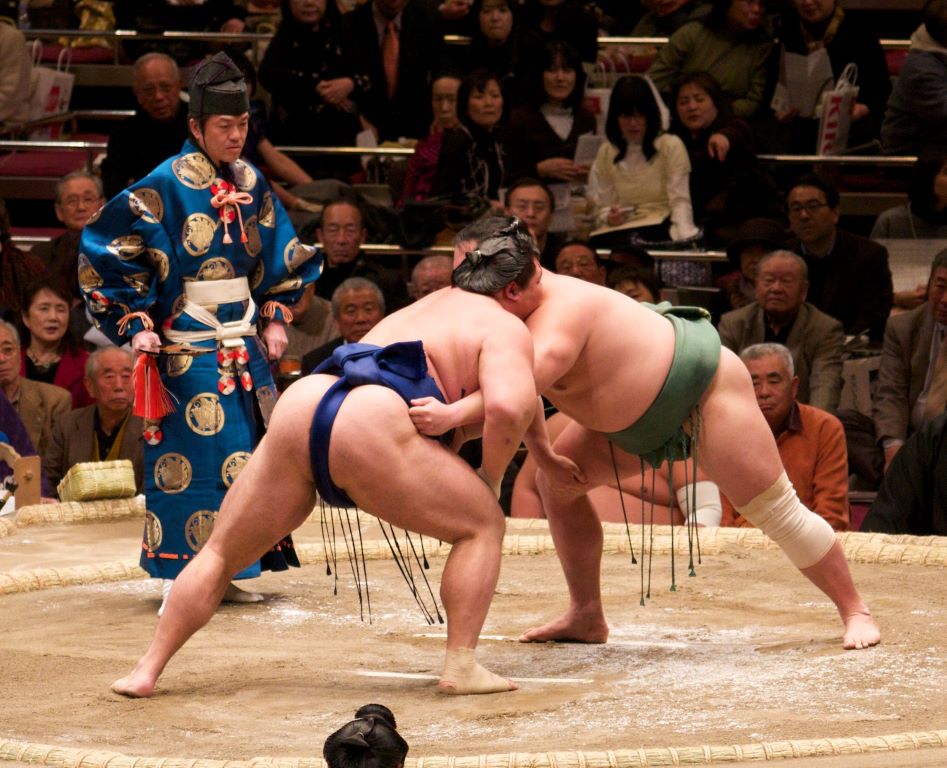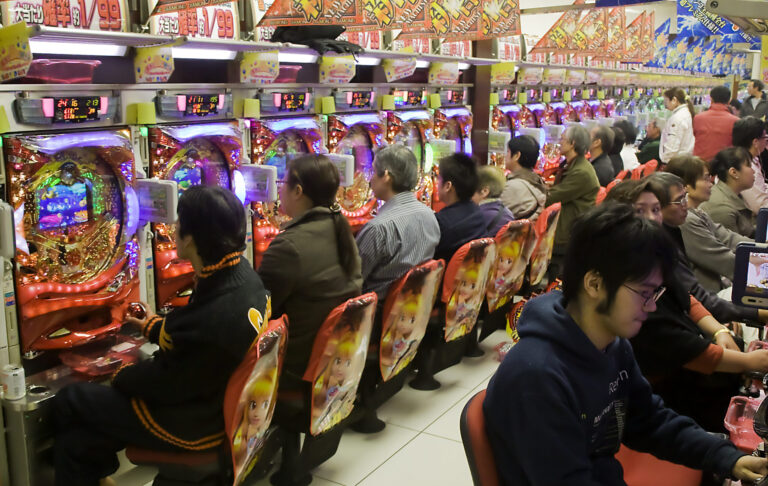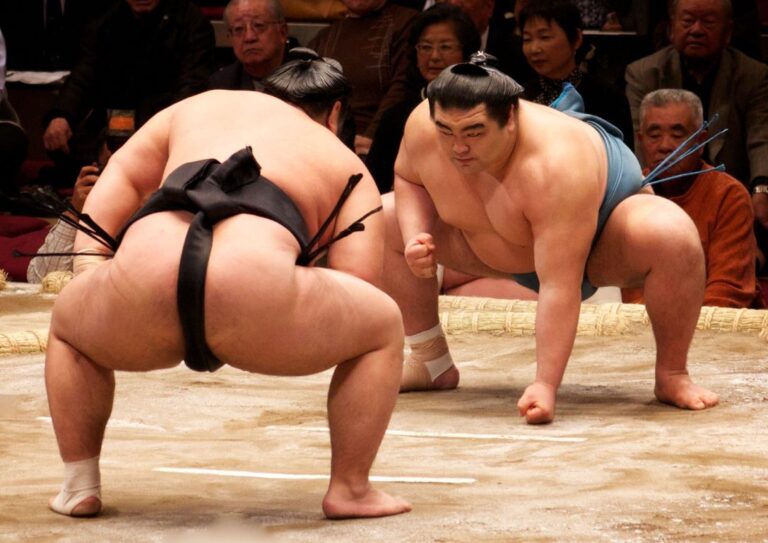Two men enter the 5-foot round platform and face the crowded arena. They clap their hands and then stomp their legs, driving evil spirits from the ring. Once finished, they retreat to opposite corners, each taking a ladleful of “power water” with which to rinse his mouth and a “power paper” with which to dry his face. Stepping into the center of the ring, they squat face-to-face, clap their hands once more, and show their opponent that they’re carrying nothing but the strength of their bare hands. Back to their corners, they each pick up a fistful of salt, tossing it into the ring for purification. Returning to the center and their starting lines, they squat down again while facing each other, staring unbroken into one another’s eyes. With no signal or word passed between them, they spring! Arms wrapped around one another, they shove and dance across the platform, trying to push one another out of the ring! In minutes, or even seconds—after all that preparation—it’s over!
Sumo wrestling is said to have begun in the heavens, when the gods Takemikazuchi and Takeminakata sumo wrestled along the coast of the Sea of Japan for the right to rule the Japanese islands. In a more historical sense, early forms of sumo wrestling first appeared in Japan sometime during the 8th century CE to entertain the imperial court. These early wrestling matches became what is known as sumo wrestling today in the late 17th century. Samurai warriors were the first sumo wrestlers; they used these strength tests to entertain the warlords and to train for battle. Eventually, men emerged who devoted their lives to the sport.
The Sumo Wrestler
Sumo wrestlers (called rikishi in Japan) fit into three weight groups: lightweight (up to 187 pounds), middleweight (187-252 pounds), and heavyweight (252 pounds or more). Despite their girth, they’re typically very healthy individuals who follow a strict exercise and diet regimen meant to build their weight while keeping them strong and flexible. Only men are allowed to be sumo wrestlers in professional and traditional leagues (read on for a note about women at sumo matches), but there are amateur women’s sumo leagues as well.
Sumo wrestlers wear their hair in a specialized topknot called the chonmage, even while in public. During a sumo match, they appear in only a black loincloth-like belt called the mawashi. The more decorated the mawashi is, the higher rank the wrestler has obtained. It is essential that the mawashi is worn properly, as a mawashi that comes undone during the sumo match results in an automatic loss!
The Match
Sumo is mostly about the theatrics of building up to that moment of anticipation: the tachi-ai, the moment the sumo wrestlers charge at one another in a burst of frantic energy. That rounded platform, called the douyou, is basically a stage. In upper divisions of the sport, that stare-down before the tachi-ai followed by salt platform purification, called the shikiri-sen, can be repeated as many as three—or even more—times until the gyouji (referee) tells the wrestlers that the match must begin. The victor is the wrestler who either forces his opponent to touch the ground with any part of his body save the soles of his feet or the wrestler who forces his opponent out of the ring entirely. All in all, the preparation rituals can take up to four minutes, while the actual match often lasts less than one!
Should the wrestling match drag on for four minutes, the gyouji allows a mizu-iri (a break for a drink of water). The gyouji is then responsible for repositioning the wrestlers in exactly the same position they were before the break. The match is allowed to continue for up to another four minutes, after which the wrestlers are determined to be deadlocked and are allowed another break. After this break, they start the match from the beginning at the starting lines, with no wrestler in a more favorable position than the other. They are allowed to wrestle for another four minutes and if no victor is determined, the match is called a draw. However, this rarely happens. The last time a draw was called at a high-ranking professional match was nearly thirty-five years ago!
Religious Influence
The Japanese Shinto religion plays a part in all those sumo preparation rituals. The initial leg-stomping the wrestlers perform while facing the audience (called shiko exercises) were born from the Shinto idea that evil spirits might influence the outcome of the sporting match. The clapping is intended to attract the attention of favorable kami (gods or spirits), and the stomping is meant to crush the akuma (devils) underfoot. The “power water” (chikara-mizu) and “power paper” (chikara-gami) are ordinary water and Japanese paper; nonetheless, they’re intended for the wrestlers to purify themselves for the kami watching the match. Of course, the salt purification of the platform is another religious influence.
One negative religious influence is that women are not allowed to touch the douyou platform at any time before, during, or after a traditional sumo match. (Shinto beliefs stated that women would taint the purity of the platform.) Even a female governor who attended a match and gave out a prize in the late 1990s was not allowed to stand near the platform!



